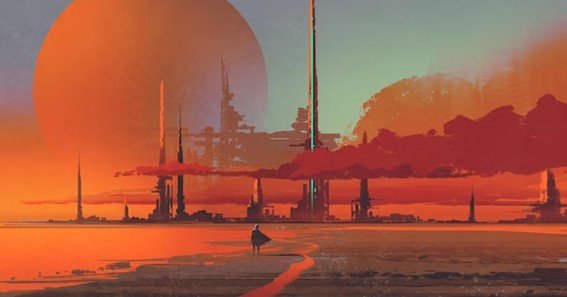Science fiction (sci-fi) painting is a genre that merges artistic creativity with imaginative visions of the future, alternate realities, and extraterrestrial landscapes. By blending elements of science, technology, and speculative fiction, sci-fi artists transport viewers to realms beyond our current experience, challenging perceptions and inspiring wonder.
Techniques in Sci-Fi Painting
Sci-fi painting encompasses a variety of techniques, each contributing to the creation of otherworldly imagery:
-
Digital Painting: Utilizing software tools, artists can craft intricate sci-fi scenes with precision, allowing for experimentation with light, texture, and composition.
-
Traditional Media: Oil and acrylic paints remain popular for their rich textures and depth, enabling artists to convey complex atmospheres and emotions. For those interested in learning traditional methods, resources like Patrick J. Jones’ “Sci-Fi & Fantasy Oil Painting Techniques” offer valuable insights.
-
Mixed Media: Combining various materials and techniques, artists can achieve unique effects that enhance the surreal qualities of sci-fi art.
Influential Sci-Fi Artists
Several artists have significantly shaped the sci-fi painting landscape:
-
Donato Giancola: Known for his narrative realism, Giancola’s work often depicts scenes from J.R.R. Tolkien’s Middle-earth, blending classical techniques with fantastical subjects.
-
Eliot Greenwald: A self-taught artist, Greenwald’s “Night Car” series presents sci-fi, psychedelic Americana landscapes, characterized by vibrant colors and surreal compositions.
-
Scott Listfield: Renowned for his astronaut-themed paintings, Listfield explores themes of isolation and exploration in futuristic settings.
Inspirations Behind Sci-Fi Art
The inspiration for sci-fi paintings often stems from various sources:
-
Literature: Classic and contemporary science fiction novels provide rich narratives and concepts that artists visualize through their work.
-
Technology: Advancements in technology and space exploration ignite imaginations, leading to artistic interpretations of potential futures.
-
Social Commentary: Sci-fi art frequently reflects societal concerns, using futuristic allegories to comment on present-day issues.
Conclusion
Sci-fi painting is a dynamic and evolving genre that continues to captivate audiences by exploring the boundaries of imagination. Through diverse techniques and inspirations, artists create visual narratives that challenge our understanding of reality and provoke thought about the possibilities that lie ahead.
FAQs
1. What defines sci-fi painting?
Sci-fi painting involves creating artwork that depicts futuristic, speculative, or imaginative scenes, often incorporating elements of science fiction such as advanced technology, space exploration, and alien landscapes.
2. Which mediums are commonly used in sci-fi painting?
Artists employ various mediums, including digital tools, oil paints, acrylics, and mixed media, to achieve the desired effects in their sci-fi artwork.
3. How can one learn sci-fi painting techniques?
Aspiring artists can explore instructional resources like Patrick J. Jones’ “Sci-Fi & Fantasy Oil Painting Techniques” or participate in workshops and online courses focused on this genre.
4. Who are some notable sci-fi painters?
Artists such as Donato Giancola, Eliot Greenwald, and Scott Listfield have made significant contributions to the field of sci-fi painting.
5. Can sci-fi painting be used in film or video games?
Yes, sci-fi paintings are often used in the conceptual development of movies, TV shows, and video games. They help visualize futuristic environments, characters, vehicles, and technologies before being brought to life with CGI or special effects.










